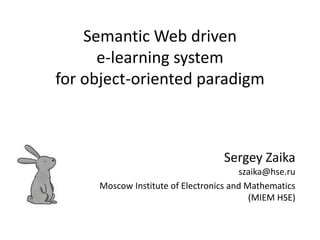Semantic Web driven e-learning system for object oriented paradigm (position paper)
- 1. Semantic Web driven e-learning system for object-oriented paradigm Sergey Zaika szaika@hse.ru Moscow Institute of Electronics and Mathematics (MIEM HSE)
- 2. Background works In MIEM before me: Ontology based electronic practice book for Smalltalk-80 && Prolog for internal usage My project: Design of the Semantic Web driven electronic practice book for Smalltalk Squeak My graduate paper topic first thought: Semantic Web driven e-learing system for object-oriented paradigm 1
- 3. Possible two directions 1. To build SW-based plugin for Moodle to help moodle-folks semi-automatic navigate & control their course storagies 2. To create my own domain ontology for OOP linked with my system of practical tasks which reveal the issues of an OO paradigm good enough 2
- 4. I SW-based plugin for Moodle for semi-automatic navigate & control their course storagies
- 5. The problem 1. Moodle is one of the most popular LMS in Russia 2. People may use it (it’s a proved fact) to store over 100 different courses 3. Moodle has a lack tools to effectively control such groups of this courses 4. The most part of the educational content created by the teachers and students 5. No SCORM, only internal moodle format 4
- 6. Moodle internal data •Taxonomy •Lecture •Quiz 5
- 7. LMUdle Scherl, A., Dethleffsen, K., & Meyer, M. (2012). Interactive knowledge networks for interdisciplinary course navigation within Moodle. Advances in physiology education, 36(4), 284-297. 6
- 8. Summary about this Moodle extention • It requested by several educational institutions • The problem is specific & local • Some possibilities to write an guide and get more markuped educational content to work with (something that already created but not shared) 9
- 9. II my own domain ontology for OOP && some system of practical tasks
- 10. Yet another OOP educational content? • https://www.coursera.org/course/proglang • http://ocw.mit.edu/courses/electrical-engineering-and-computer- science/6-01sc-introduction-to-electrical-engineering- and-computer-science-i-spring-2011/unit- 1-software-engineering/object-oriented-programming/ • http://www.codecademy.com/courses/intro-to-object-oriented- programming/0/1 • http://mooc.cs.helsinki.fi/programming-part1 9
- 11. Related work: Semantic IDE project http://www.slideshare.net/dagrachev/semantic-ide 7
- 12. Related works: Java & C ontologies • John, S. (2014). Development of an Educational Ontology for Java Programming (JLEO) with a Hybrid Methodology Derived from Conventional Software Engineering Process Models. International Journal of Information & Education Technology, 4(4). • Sosnovsky, S., & Gavrilova, T. (2006). Development of Educational Ontology for C-programming. 8
- 14. Partonomy snippets (on russian) knowledges skills Domain terms 12 Near 75 nodes for now
- 15. Summary about this educational ontology 1. New good stuff for the LOD and other SW-based educational projects 2. Reusable set of domain specific practical tasks 3. Competency-based approach (main stream for The Ministry of Education and sciense of Russia) 4. Possibility for trying some adaptive approaches (Bloom taxonomy, Felder-Silverman learning styles) 10
- 16. Summary • This two different directions or this research with a little hope to be joined in the future • Some designs of domain ontology • Definition of some specific but important problem for our russian e-learning 13
- 17. Thank you for your attention Sergey Zaika - szaika@hse.ru Moscow Institute of Electronics and Mathematics (MIEM HSE)
Editor's Notes
- #2: Hello everyone. My name Sergey Zaika and I dlike to discuss some future possible directions of my research.
- #3: A few words about my background. So, in MIEM there was a two simple electronic practical books before me for an Smalltalk-80 and Prolog languages. As my student project, I decide to refresh an programm When My graduate paper was about an ontology based electronic practice book for Smalltalk-80 programming language. So the first thought for my post-graduate paper was to extend this approach and create something bigger in the same way
- #15: Clean concepts 2 Pure object-orientation 3 Safety 4 High level 5 Simple object/execution model 6 Readable syntax 7 No redundancy 8 Small 9 Easy transition to other languages 10 Support for correctness assurance 11 Suitable environment

















